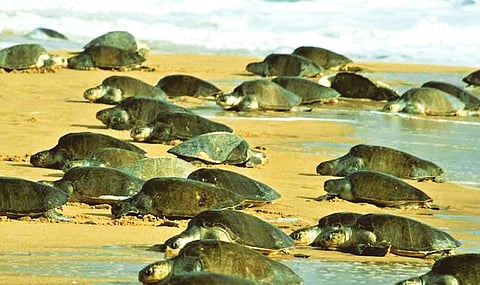

Every year, Olive Ridley turtles arrive en masse at a few of Goa's beaches around this time of year
PIC CREDIT: asianadventures.net
Have you ever seen little turtle hatchlings making their way to the sea? Every year, from October to April, Olive Ridley turtles head to the shores of Goa for nesting. The turtles lay hundreds of eggs, and after the incubation period of around two months, tiny turtles head back to the sea — a fascinating sight to watch!
A couple of beaches in Goa are natural habitats for Olive Ridley turtles, and are the best spots to witness this phenomenon. The popular beaches are Morjim in North Goa, while Galgibaga (sometimes called Turtle Beach), Agonda and Talpona are located in South Goa. These beaches were notified for protecting and facilitating turtle nesting in the 1990s.
TURTLES IN GOA
The Olive Ridley turtle (Lepidochelys olivacea) is a small sea turtle. The adult grows to approx 60 cm to 70 cm in length, and its shell (carapace) is usually heart shaped. Considered the smallest and most abundant sea turtle in the world, their numbers have decreased greatly over the past few years because of the few remaining nesting sites globally. It is recognised as vulnerable by the IUCN (International Union for Conservation of Nature) Red list.
Every year, the Olive Ridley turtles found off Goa’s coast, head towards the shore for nesting. They lay hundreds of eggs. On hatching, the hatchlings head back to the sea. The entire process takes place under the watchful eye of conservationists, who ensure nobody harms the turtles.
The female turtle lays 80 to 120 eggs in a season. Their synchronised nesting en masse is known as ‘arribadas’, and females return to the same beach (where they hatched) throughout their lifetime to lay eggs.
During this year’s nesting season, the first Olive Ridley turtle reached Agonda, in South Goa, on December 31, 2021 and laid 118 eggs. At Galgibaga, the first Olive Ridley turtle arrived on January 3, 2022 and laid 117 eggs.
Nesting season usually starts in the month of September, though lately, it has moved to January and ends by about March, April and sometimes May. This change in the start of the nesting season is attributed to climate change. Tourists and noisy surroundings also affect this species, so a lot of times, the eggs are shifted by local Forest Department authorities to a small turtle Interpretation Centre so that they are protected during the incubation period.
Female Ridleys nest on the same beach where they were born, three to four decades ago. This means that they return to the same habitat every nesting season to lay their eggs. Estimates say that the likelihood of baby hatchlings making it to adulthood range from 1 in 1,000 to 1 in 10,000.
It is believed that conservation for turtle nesting began in Goa as recently as the late nineties, when the Forest Department joined forces with the local residents. Nesting pits were created and locals were employed to keep watch around the clock to stop people from stealing eggs or stray dogs from trying to eat them. Each of the pits are believed to carry between 100 to 130 eggs.
‘No-development zones’ were put in place on the beaches by local authorities along with strict regulations relating to the building of beach structures. The north side of Galgibaga Beach, for example, was made a ‘completely protected turtle zone’ meaning no developments or structures can be built.
The turtles’ nesting period coincides with Goa’s peak tourist season. The high tourist density, beach-driving, lights, sounds, trash, temporary structures and other activites on these beaches present a hazard to natural nests, nesting turtles and incubating eggs. With the increasing light, sound and noise pollution, the number of turtle nestings has dropped considerably over the past decade.
A signboard near a turtle nesting pit on the beach
Gomantak Times
NOTES FOR TOURISTS & VISITORS
The beach gets pitch black after dark since no lights are allowed.
Don’t be surprised if there are no beach sellers at all.
Avoid taking photos. Bright lights cause much disorientation to the turtles and should be completely avoided.
Stay away from the turtle’s head.
Speak in low voices and move slowly so as not to startle the female turtle.
Don’t touch the turtle or the eggs, even long after the turtle has left. Handling eggs should only be done by trained personnel.
Avoid crowding near the turtle or making quick and sudden movements.
The nesting sites on the beaches are under the protection of the Forest Department and are clearly marked with signboards; so do follow their rules and regulations so as to not disturb their natural habitat.